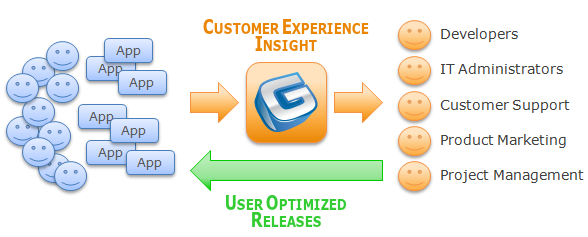Customer Experience Improvement Program (CEIP)
Loupe can be used by small- and mid-size teams to create a customer experience improvement that collects information about how your customers use your programs and about some of the problems they encounter. Loupe makes it easy to collect and analyze this data to improve your products and features customers use most often and to help solve problems.

What types of products is this suitable for?
Loupe is compatible all .NET applications built on .NET 2.0 SP1 and beyond. Loupe is particularly well-suited for creating a CEIP for desktop applications as it includes built-in capabilities to transmit data to the development team. Using Loupe to collect and analyze usage data can improve team productivity and reduce testing and support costs for a wide variety of teams:
- In-house corporate development projects benefit by having usage data to track adoption rates by the organization as well as proactively tracking and responding to any user errors that occur.
- Outsourced software development projects benefit by accelerated problem diagnosis and troubleshooting resulting in shorter test schedules and higher customer satisfaction. Both the consultant and the client benefit by having detailed usage data documenting adequate testing with acceptable error rates.
- Independent Software Vendors (ISV/mISV/uISV) benefit by improved understanding of their customers and an enhanced ability to quickly respond to issues and build customer loyalty.
What data does Loupe collect?
Loupe efficiently and safely records errors, system events, trace messages, configuration details, system performance metrics and application-specific custom metrics. It transmits this information to the software team, indexes it, aggregates it, and provides powerful tools for the team to explore broad patterns across multiple users as well as drilling down to analyze individual sessions.
Custom metrics are particularly important for CEIP programs because they enable simple data collection and analysis of a broad range useful data. Typical usages include tracking feature utilization and monitoring system throughput, performance, and reliability.
How does Loupe manage all that data?
Loupe indexes incoming session data providing reporting and data analysis functions that let you monitor patterns across multiple sessions as well as drill-down into the details of a single session. This includes automatically categorizing sessions by length, operating system, computer and linking each unique error with the associated sessions in which it occurs.
Loupe can easily manage thousands of sessions making it suitable for many projects. Loupe is attractive to many teams because it is a very affordable solution that is easily integrated with their products and workflow.
How are privacy concerns addressed?
Loupe has the flexibility to work with whatever privacy policy is appropriate for your .NET products. You can configure what information is collected and when collected data is sent to implement a broad range of policies, such as:
- Automatic transmission of all information is often appropriate for beta testing or in-house corporate applications for which users have granted consent as part of agreements they accepted prior to installing the program.
- Automatic transmission after opt-in may be appropriate for commercial software products to ensure informed consent and maintain a high-degree of transparency and trust with your customers.
- Prompt for transmission after errors asks the user for consent to transmit log data at the end of an application session only if the session contains errors.
- Transmit upon user request makes it easy for a customer to submit data when they wish. This option is available by default in Loupe-enabled applications by clicking a configurable hotkey or it can be invoked programmatically with one line of code.



